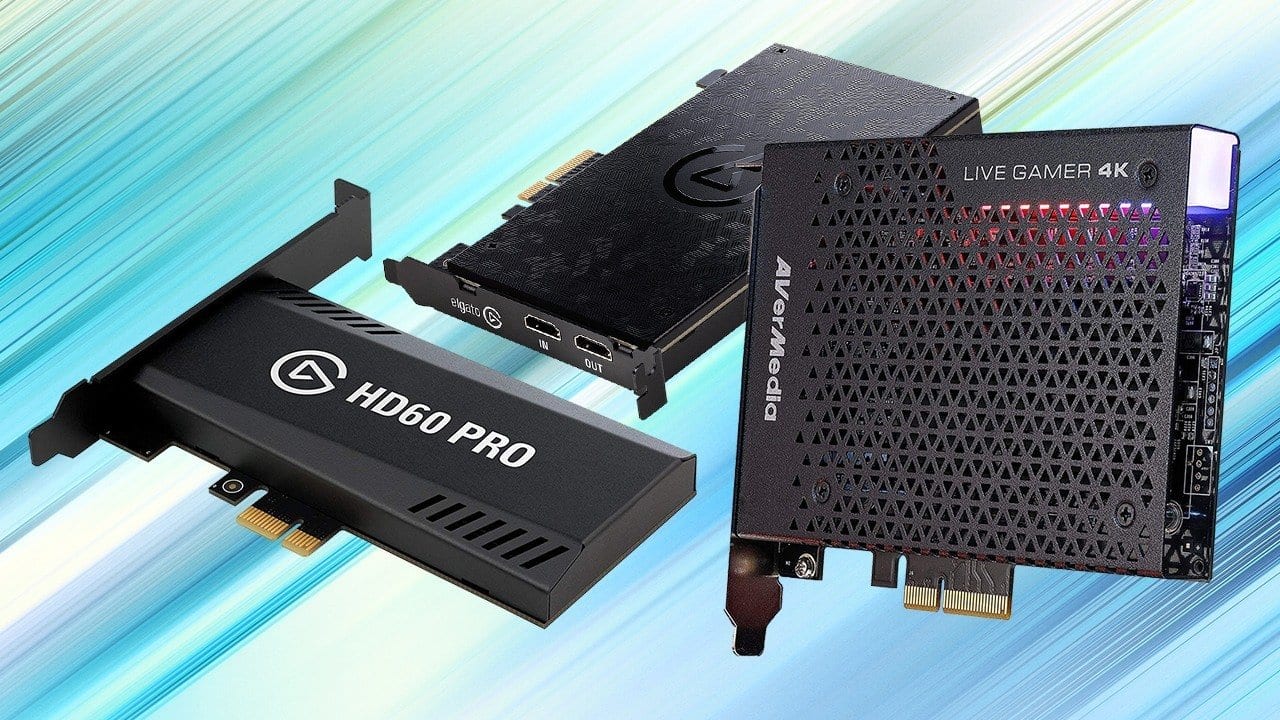
For gamers who like to share their gameplay on streaming platforms or create gaming videos, a capture card is a great investment to provide high-quality streaming and recording that stands out from the competition as well as establish, grow, and maintain a wide fan base. So, we are providing you here with our picks for the best capture cards available right now.
Our Top Picks
Elgato Game Capture HD60 S

The HD60 S is an external capture card with a USB 3.0 Type C Connection and an HDMI output. It is able to capture footage with 1080p resolution at 60 FPS with a bitrate up to 40 Mbps.
It has several features like Instant Gameview which allows streaming with low latency directly to Twitch or YouTube through the built-in live streaming. It also features Flashback Recording in case you forgot to hit the record button, and Stream Command to customize the stream like adding the webcam feed, overlays, alerts, and layouts. It also provides a built-in Live Commentary feature to add your commentary to the footage you capture.
The HD60 S is compatible with both PC and Mac, as well as several consoles including PS4, Xbox One, Xbox 360, Wii U, and Nintendo Switch.
Pros
- High compatibility with several devices, works with Windows and Mac OS
- High-quality video at 60 FPS with low latency streaming
- USB 3.0 provides fast transfer speed and minimizes latency
Cons
- Limited editing software, only capable of trimming video
- Doesn’t support encoding
Elgato Game Capture 4K60 Pro

The Elgato 4K60 Pro is one of the very first capture cards with the ability to capture video at a 4K resolution. It supports up to 2160p at 60 FPS with a bitrate up to 140 Mbps. It’s an internal card with a four-slot PCIe interface, HDMI in and HDMI out to project the lag-free footage on a 4K monitor or TV screen.
The card supports Instant Gameview, Flashback Recording, and Stream Command. It comes with user-friendly software that encodes the video during recording in order to reduce the file size and save space. It provides exporting functionality to transfer your captured footage to your editing software.
This card is compatible with PC, PS4, and Xbox One. It requires at least a 6th generation Intel i7 or an AMD Ryzen 7 CPU, and NVIDIA GeForce 10 series or AMD RX Vega GPU.
Pros
- 4K resolution at 60 FPS video capture
- Good software with video encoding capability
Cons
- Expensive
- Requires a high-end PC to run on
AVerMedia Live Gamer Extreme 2 (GC551)

The Live Gamer Extreme card is an external card capable of capturing uncompressed video with a resolution of 1080p at 60 FPS. It uses a USB 3.1 Type C connection and has HDMI pass-through that can provide 4K resolution at 60 FPS with low latency when playing on a second monitor.
The card provides an audio mix-in feature which allows you to instantly add background music to the stream or include live voice commentary using the two 3.5mm auxiliary and microphone jacks for audio inputs. It also comes with RECentral, a streaming and editing software capable of trimming, time-shifting, merging, and picture-in-picture (PIP) to add your webcam feed to the gameplay, your logo, or image overlay.
The LGX is compatible with PC, PS3, PS4, Xbox One, Xbox 360, and Wii U.
Pros
- 4K resolution at 60 FPS Pass-Through with no lag
- Full HD uncompressed video recording
- Powerful editing software with several functions and includes a Cyberlink PowerDirector 15 video editing software product key card
Cons
- Only supports Windows
AVerMedia Live Gamer Portable 2 Plus (GC513)

This external capture card can run in PC-free mode; it can record videos directly to a microSD card without the need for a PC. It records in 1080p at 60 FPS and includes 4K pass-through so that you can play in Ultra HD 4K resolution while recording in Full HD.
It provides several features like Headset Commentary to add your easily add your voice to the streaming or recording, Console Party Chat to capture and include your chats in the footage, a hot button to instantly stream to Twitch or YouTube. The card includes RECentral and also supports software like OBS and XSplit.
It is compatible with PC, Xbox, PlayStation, Wii U, Nintendo Switch, and NES Classic.
Pros
- Doesn’t need a PC to run which provides extra portability
- Can record directly to microSD card in PC-free mode
- 4K resolution at 60 FPS Pass-Through
Cons
- Can’t stream or record in 4K
Razer Ripsaw

The Razer Ripsaw external capture card provides the ability to capture uncompressed game footage in Full HD 1080p at 60 FPS. It uses USB 3.0 to allow low latency streaming.
The card includes an audio mix-in channel with two inputs for auxiliary music as well as a microphone to add voice commentary. It also supports several capture software like OBS and XSplit.
The Ripsaw is compatible PC, Razer, Forge TV, Xbox One, Xbox 360, PS4, PS3, Wii U, and Nintendo Switch. It also has a retro port that comes with component cables to provide support for older consoles like NES and SNES.
Pros
- Compatibility with older consoles as well as last-gen consoles
- Provides uncompressed raw data for streaming
Cons
- Slightly worse latency than the other options
What is a Capture Card?
A capture card is a hardware device you can use to capture footage from a PC, a gaming console, or a TV. The captured video can be directly streamed to online streaming platforms like Twitch, or it can be recorded and saved for later to be edited and uploaded to online social media platforms like YouTube and Facebook.
Capture cards are most commonly used by professional gamers to live stream their gameplay on Twitch in real time or to record their in-game sessions in order to create gaming content to be uploaded on YouTube like gameplay videos, walkthrough videos, or tips and guides videos. Capture cards can also be used to record TV shows and series to watch them later or even turn old DVD movies to HD format.
How Does It Work?
Capture cards can work with gaming consoles as well as PCs. In case of a console like PlayStation or Xbox, the capture card is connected to the console through an HDMI cable for the video input signal. The card has two outputs, one to the TV to see the game you’re playing, and the other to a PC via USB so that you can stream or record the footage using a capture software.
If you’re gaming on a PC, you’ll most probably need another PC or a laptop to use as the streaming and recording device. The capture card establishes a connection between your gaming PC and your streaming PC. The GPU of your gaming PC will send the video signal through the HDMI connection to the capture card, which along with the second PC will be responsible for the encoding and streaming of the footage without affecting the performance of your primary PC. You could also use an internal capture card with a single PC but it will affect its performance.
Do I Need One?
Deciding whether you should buy a capture card or not depend mainly on the type of gaming device you’re gonna use it with. Generally speaking, capture cards are more beneficial for console gamers than for PC gamers.
If you have a high-performance single system PC, you won’t need a capture card. You can stream and record your gameplay at the same time by simply using a broadcasting software. The drawback of doing this is that the performance could be affected because your CPU will be doing the encoding tasks which are very resource-intensive. You’ll need an ultra high-end gaming system to handle all this without any lags. In this case, it’s better to invest in upgrading your CPU instead of buying an internal capture card.
The more sensible option is to use the capture card with a dual system PC, where you will be able to preserve the quality of the game and play at a high frame rate per second (FPS) while also streaming and recording at high definition. The two PCs will be connected together through the capture card, with the second PC and the card doing all the high load encoding, streaming, and recording stuff, freeing the load on the main PC to concentrate only on running the game with the highest quality possible. So for PC users, if you want to maintain your competitive edge in gaming while also producing high-quality streamable content, it’s a good decision to invest in a capture card alongside a second PC dedicated for streaming and recording.
For consoles, capture cards are extremely useful. Old consoles don’t have built-in tools for streaming and recording, so you can only do it through a capture card on these consoles. The PS4 and Xbox One come with built-in software to record and stream on Twitch, but they each come with their own limitations. For example, the PS4 software can only record up to 15 minutes continuously, while the Xbox One can only record up to 5 minutes. There are also limitations on the customization and editing of the stream. So, it’s best to use a capture card to transfer your gameplay footage from the console to a PC for streaming, recording, and editing. This will give you total control over your footage, allowing for better flexibility and customization of your videos, providing high-quality streaming without any lagging, and helping maintain a library of your gameplay.
What to Consider When Buying a Capture Card?
Internal vs External
Internal cards provide better performance as they connect to PCIe slots which are faster than the USB connections. On the other hand, external cards are better for portability, especially if you don’t have your console near your PC. Some also come with internal memory or provide the option to connect an external hard drive to store recordings on.
Video Quality
You need to know the quality of the captured footage if you want to choose a card that supports it. You should know the resolution whether it will be high definition (HD) or standard definition, you might also consider going up all the way to 4K, but you won’t be able to stream it to Twitch as the platform still doesn’t support 4K yet, unlike YouTube. The frame rate is also important, whether you need 30 FPS or 60 FPS. Also, make sure that all the other devices in your system are capable of producing the quality you want and that your internet connection can provide the necessary upload speed to handle such quality in case of streaming.
Compatibility
You must make sure that the capture card you purchase is compatible with the devices you want to use it with, like PC, PS4, Xbox One, Nintendo Switch. Having a card that is compatible with more devices will give you more flexibility in case you decide to change your gaming setup. Also, supporting several and more common connectors and ports, like HDMI, will make it more easy to use with as many devices as possible.
Software
You might also want to consider the software bundled with the card. Having a card and good quality software included with it will save you the trouble and cost of looking for an alternative software solution.
Wrap Up
For the best value capture card, you should consider the Elgato HD60 S. It will provide you with the best quality and performance at an affordable price but you’ll have to rely on additional software for better editing.
If you’re looking for more portability, the AVerMedia Portable 2 Plus is a great option with the support of PC-free microSD recording and you can still play at 4K resolution. Also, you won’t have to worry about the software as it provides a good bundled package.
Finally, if you want the highest quality possible and can afford to pay for it, then the Elgato 4K60 Pro is definitely the one for you.



